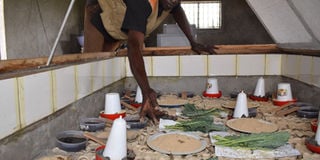Crickets are better than chicken: farmer

Mr Charles Odira at his cricket farm in Kisumu. Mr Odira processes dried crickets into flour for food security. Crickets are nutritious and researchers say cricket farming is more environmentally friendly compared to poultry farming. PHOTO | ELIZABETH OJINA | NATION MEDIA GROUP
What you need to know:
- Rearing of crickets is independent of climate change. Farmers are able to rear them throughout the year.
- They are nutritious and have a high protein content.
Scientists last year proposed that farming crickets could be safer for our environment compared to rearing chickens.
The study seems to have strengthened the resolve of some farmers who have embraced cricket farming.
FARMING
Mr Charles Odira has farms crickets in Kisumu as a source of income and food.
With locally fabricated machines, the farmer processes dried crickets into flour to make cakes, muffins and biscuits for sale.
The insects are known to chirp and irritate many people, but Mr Odira excitedly says they are a good source of protein.
“They are noisy, at times," he admits.
At his farm in Nyamasaria, crickets are housed under sheds that are kept clean and the insects are routinely supplied with clean water, crushed grain, sukuma wiki and some traditional herbs.
They are also fed on soy bean, fish meal and some minerals dissolved in water.
Crickets need a high supply of proteins and minerals to breed and survive, Mr Odira says. Otherwise, they could eat other crickets.
"They require strict hygiene. So you have to keep cleaning their sheds from time to time, emptying the waste and ensuring no contamination,” Mr Odira said.
CARE
Crickets can breed quickly, often multiplying within 10 days.
They are susceptible to bacteria, but a dirty environment can push them to escape.
Mr Odira does not sell the insects directly. He instead takes the mature ones and dries them. He then crushes them to make flour, which he mixes with wheat flour for baking.
“Experts say if you eat two crickets in a week you are guaranteed more protein content than one person who eats chicken regularly. In addition, they are safer for the environment,” says Mr Odira.
RESEARCH
Last year, a report published by scientists at the University of Copenhagen compared cricket production in Thailand to broiler chicken farming on equivalent scale and found that crickets were better for the environment.
Fifteen environmental impacts were investigated, including global warming potential, resource depletion and eutrophication.
According to the report, cricket production had a lower negative impact on the environment that the rearing of broiler chicken.
In addition rearing of crickets is independent of climate change. Therefore farmers are able to rear them throughout the year and thus their profitability is sustainable.
Egerton University Department of Dairy Food Science researcher Godfrey Were says chicken produce more waste than crickets despite giving them the same quantity of feeds.
“Generally broiler chicken feed a lot compared to cricket. As a result chicken end up producing more waste than cricket who give low output to the environment,” says Mr Were.
He says the methane gas emitted from chicken waste will be higher than the waste emitted from crickets.
“Because of the small contribution of waste of crickets they are seen to have little contribution to the global warming effect and environmental degradation,” says Mr Were.
FOOD
The chicken feed that is also fed to farmed crickets is a mixture of corn or maize, soy, fishmeal and rice meal.
Farmed crickets were found to be extremely efficient at converting the feed they were given – which happens to be the same quantity as is given to broiler chickens – into protein.
“If you give 5gm of feeds to both chicken and cricket, the conversion of the protein in crickets is higher than broiler chicken,”
Reared crickets have double the number of protein content compared to broiler chicken.
“House reared crickets have 60 per cent protein content compared to chicken which has slightly protein content of 30 per cent,” says the Egerton researcher.
The farming of insects, which are typically high in protein and low in fat, avoids some of the other ethical quandaries that are occasioned by industrial-scale farming of intelligent animals like pigs.
NUTRITION
In many cases insects can be comparable to meat and fish in terms of nutritional value.
According to the Association of Dutch Insect Farmers, cricket farming is a viable option for solving widespread cases of malnutrition and kwashiorkor.
With crickets, you can capture in the wild and rear it in a closed set-up. Typically crickets take a few weeks for adult females to start laying eggs which can be used to expand a farm.
Crickets are rich in fatty acids, calcium, iron, and vitamin B12.
Around the world, there are more than 2,000 insect species that are regularly eaten. Most of these species are harvested from the wild, but around nine insect species are currently farmed for food and feed.




